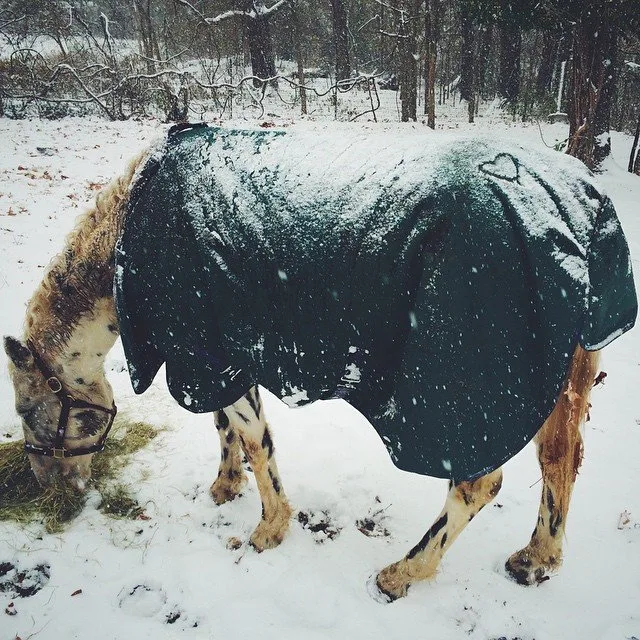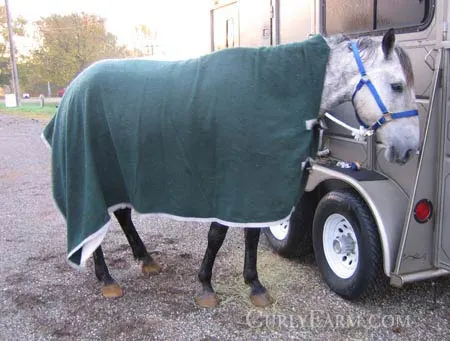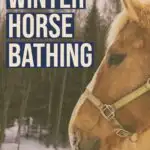Bathing your horse is a regular part of caring for your horse, but knowing when it’s too cold to bathe- and how to give a horse a bath if it is very cold outside- is an important part of horse ownership. Mostly winter baths can be avoided, but if you compete in shows during the winter (the typical “off season”) you may need to know how to decide if it’s too cold to bathe your horse.
This article has three parts, jump to the section you need:
- How to know if it’s too cold to bathe your horse
- Method for bathing a horse in freezing temperatures
- Bath Alternatives for Cold Weather Grooming
- Teaching your horse to stand for a bath
How To Know If It’s Too Cold To Bathe Your Horse
First, know that “too cold to bathe” is relative to your horse and your equipment. With the right equipment and a healthy horse, you can safely bathe a horse when temperatures drop to 15 F or even lower!
Things you’ll need to be able to safely bathe a horse in cold weather:
- a source of warm water
- shelter from wind/rain
- sweat scraper
- towels
- (2) horse coolers
- time to fully dry your horse

Factors to consider include:
- Is my horse generally healthy and tough?
- Do I have warm water available to bathe?
- Is my horse clipped or wearing a full winter coat?
- Do I have a cooler (read on for alternate options)?
- Do I have sufficient time to dry my horse’s coat?
- Do I absolutely need to bathe my horse?
A healthy horse should be able to handle a bath with no special treatment in temperatures as low as 50 F. Generally, unless we have a horse show or breed demo we try not to bathe horses in temperatures below 65 F. However, healthy, cooled out (not overheated from exercise) horses can be bathed into freezing temperatures if you ensure they stay warm throughout the bathing process and until they are completely dry.
Drying a horse with a full winter coat can be a long process, and you might get nearly-as-good results by an alternative cleaning method such as a deep head-to-toe grooming with standard grooming supplies or a bath alternative described below.
How to Give a Horse a Bath when it’s Cold
Step 1. Use Hot Water
When you bathe your horse in winter, use the warmest water you have access to that is comfortable for your horse. Hot water cleans better and dries faster (at least, according to the University of Illinois). If you only have access to cold water, work to complete the bath as fast as you can- preferably with a helper so you can soap and scrape excess water off of the horse twice as fast.
If you don’t have a partner to help speed the bath- work in small sections sudsing, rinsing, and scraping each section before moving to the next.
Step 2. Soap and Scrape
Winter baths probably won’t be as thorough, so shop around to find a shampoo that will safely biodegrade if left on the coat without leaving a residue.
It’s important to use a sweat scraper to scrape the coat thoroughly after a winter bath- preferably with a rubber-edged scraper as this type will conform to the contours of the horse’s skin and remove more water.
Step 3. Actively Dry your Horse
After you’ve rinsed thoroughly and scraped well, you’ll need to help your horse dry. This is a not-complicated process if your horse is clipped, but if your horse has a full winter coat expect this drying process to take hours.
How to Dry a Horse after a Winter Bath:
First, use old towels or any scrap fabric to towel dry as much moisture off the body and legs as you can.
Next, lay a few old towels across the horse’s back, then carefully place a cooler over the horse’s back. I prefer Irish knit cotton coolers with a second wool cooler layered on top if possible. Do not put a winter blanket on your horse if they are wet. Blankets protect a coat from rain and show- with means they won’t be able to vent moisture on the coat away from the body.

Once wearing a cooler, walk your horse around in the warmest area you have access to- an indoor arena, up and down a barn aisle, or even just up and down a windbreak outside.
After 10 or 15 minutes, remove the towels under the blankets. The towels should be damp and will expose the dry cooler to the fur so it can wick more water out of the coat. Your horse doesn’t need to walk constantly during the drying process, but keep a close eye to be sure the horse does not become chilled. In very cold temperatures, offer your horse a hay bag so they use the natural warming process of digestion.
Depending on the thickness of your horses winter coat, drying will take anywhere from 1 hour to several hours. After a while, you can place your horse in a clean stall, but stay nearby until your horse is fully dry- you can gauge this by testing if, when you ruffle his coat, the hair next to the skin is dry.
For more detailed instructions for using a horse cooler to dry a horse, see our article on using horse coolers.

Cold Weather Horse Bathing Alternatives
So you’ve got a big winter show and a really dirty horse? You’ve still got non-bath options. In the world of Bashkir Curly Horse Breed Shows, winter shows are common- in order to exhibit the horses in their curliest coats. As the owner of a nearly-white Curly horse, this is a familiar scenario.
One Bath Alternative that works very well to clean coats is the equine equivalent of a “birdbath.”
Grab some old towels, a bucket of warm water, and a non-bath bathing product like “waterless shampoo” or “bath in a bottle.”
Mix the waterless shampoo with the warm water in your bucket, then dunk your towels in the cleaning solution, wring them out, and use the wrung out towel to scrub your horse’s coat. You can apply lightly all over the body to help get a “surface clean” while keeping the skin mostly dry, or you can use this method to do a deep clean of problem areas.
Teaching your Horse to Stand for a Bath
Avoid introducing horses to baths in cold weather. The “too cold for a bath” temperature goes way up if you are working with a horse who has never been bathed. Not all horses like being bathed but every horse should learn to tolerate baths. Most horses learn to enjoy baths if introduced when they are still young and during very hot weather, when a bath is a welcome respite from the heat. If taught to tolerate baths when they are comfortable, your horse is more likely to be docile and tolerant when being bathed in cold temperatures.
There are many reasons to bathe your horse. These range from general grooming of a very dirty horse to preparing your horse for a show.
Things you Need to Give a Horse a Bath
Experience
It’s worth saying, beginners shouldn’t bathe a horse without learning how to do it properly. It’s best to have a seasoned horse expert nearby to give assistance and teach the fundamentals. I explain the basics in this article- but supervision is suggested for beginners.
Hose With Adjustable Nozzle
You need to have a hose with an adjustable nozzle. Adjustable nozzles provide various options on how the water will come out. For your horse’s muddy legs, you can use the strong stream option and a fine mist for his face.
Expandable Hose
I love expanding hoses for washing horses. They’re lighter, easier to handle, and better when portability is needed. When I’ve boarded at barns without wash stalls, it was extremely convenient to have an expandable hose in your trunk. If you have a nozzle and nose of your own you don’t have to look for one where you will need it.
Bucket
If you have a good hose, you can bathe a horse without a bucket, but the most effective way to wash your horse is to mix a concentrated shampoo in a bucket with a gallon or two of water. This diluted shampoo is easy to spread evenly over the horse – something that’s really hard to do with shampoo when applying it with your hands or straight from the bottle.
Large sponge
A large sponge can be used for applying shampoos your horse’s body, cleaning sensitive areas like their face, and when rinsing. For bathing horses, I like giant kidney-shaped sponges generally used for washing cars.
Shampoo
There are many kinds of shampoo for many uses for your horse. A popular choice is the color-enhancing shampoos. Although it’s not a requirement, they’re ideal for grey and white horses and can help keep black horses from fading in summer. Personally, I often just use human shampoo on my horses.
It’s always fun to bathe a white horse because of how satisfying it is to clean one and see them squeaky clean!
A best-selling coat whitener and brightener is the Quic Silver Shampoo–one of the first whitening shampoos for horses available. Another great option is Vetrolin Shampoo, also an awesome choice for bathing horses. It also comes in conditioner with Vitamin E, sunscreen, and essential proteins. I like this because it rinses out quickly and gives a horse an extra soft coat.
Sweat Scraper
Horses can’t be towel dried (a horse cooler is the closest we can get!) so a sweat scraper is the best option for helping a horse dry faster after a bath. Sweat scrapers work like a horse squeegee: removing excess water from the fur through the pressure of a rubber blade.
That’s all you need!
If you’ve got your water source, hose, nozzle, bucket, shampoo, sponge, and sweat scraper to scrape off the excess water off your horse, you’re ready!


Lavinia
Saturday 12th of October 2019
As a kid in the UK when we came home from a day of winter hunting, ponies and kids would be wet to the bone - all day in pouring rain ... yes, seriously ! The ponies came in at night to small unheated loose boxes and were outside in the fields all day on the farm. It being late and pitch black, faced with sopping wet animals we would rub down as best we could and then "thatch" our ponies blankets (New Zealands Rugs) with hay. Sounds weird, but we would stuff as much fluffy hay as we could between the pony's body and the blanket, put on a couple of extra surcingles to keep it all in place and we would leave them to their steaming heaven. They had loads of hay all night and did not attempt to eat their padding, and next morning they would be totally warm and dry. Worked every time.